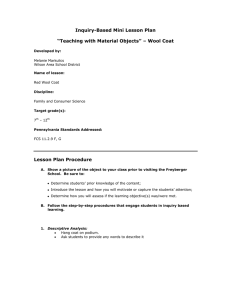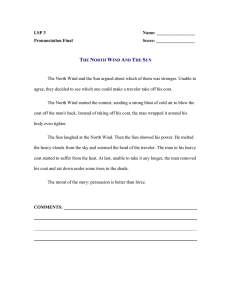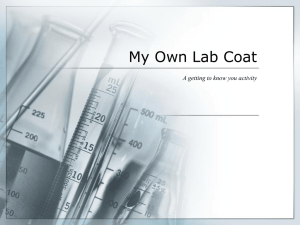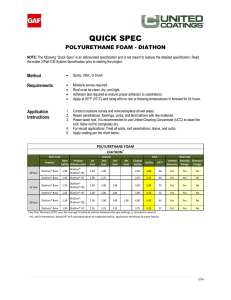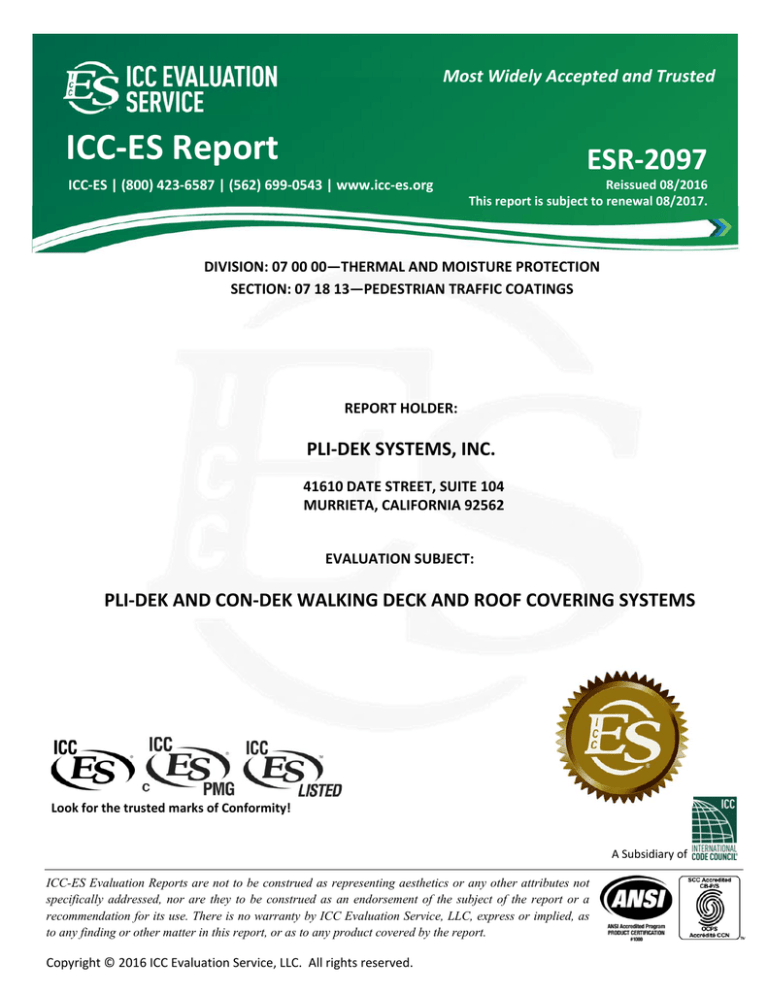
Most Widely Accepted and Trusted 0 ICC‐ES Report ESR‐2097
ICC‐ES | (800) 423‐6587 | (562) 699‐0543 | www.icc‐es.org
000 Reissued 08/2016
This report is subject to renewal 08/2017.
DIVISION: 07 00 00—THERMAL AND MOISTURE PROTECTION SECTION: 07 18 13—PEDESTRIAN TRAFFIC COATINGS REPORT HOLDER: PLI‐DEK SYSTEMS, INC. 41610 DATE STREET, SUITE 104 MURRIETA, CALIFORNIA 92562 EVALUATION SUBJECT: PLI‐DEK AND CON‐DEK WALKING DECK AND ROOF COVERING SYSTEMS Look for the trusted marks of Conformity! A Subsidiary of ICC-ES Evaluation Reports are not to be construed as representing aesthetics or any other attributes not
specifically addressed, nor are they to be construed as an endorsement of the subject of the report or a
recommendation for its use. There is no warranty by ICC Evaluation Service, LLC, express or implied, as
to any finding or other matter in this report, or as to any product covered by the report.
Copyright © 2016 ICC Evaluation Service, LLC. All rights reserved.
ICC-ES Evaluation Report
ESR-2097
Reissued August 2016
This report is subject to renewal August 2017.
www.icc-es.org | (800) 423-6587 | (562) 699-0543
A Subsidiary of the International Code Council ®
DIVISION: 07 00 00—THERMAL AND MOISTURE
PROTECTION
Section: 07 18 13—Pedestrian Traffic Coatings
reinforcing fabric layer; and intermediate and sealer
coats. See Section 4.0 and Tables 1 and 2 for recognized
system configurations and corresponding component
requirements.
REPORT HOLDER:
3.1.1 Materials:
PLI-DEK SYSTEMS, INC.
41610 DATE STREET, SUITE 104
MURRIETA, CALIFORNIA 92562
(800) 364-0287
www.plidek.com
3.1.1.1 Substrate: Exterior-grade plywood must comply
with U.S. DOC PS-1 or PS-2 Minimum thickness is
specified in Tables 1 and 2 of this report.
3.1.1.2 Metal Lath: Metal lath must be a minimum
2.5-pound-per-square-yard (1.36 kg/m2), hot-dipped
galvanized lath, complying with ASTM C847.
EVALUATION SUBJECT:
PLI-DEK AND CON-DEK WALKING DECK AND ROOF
COVERING SYSTEMS
1.0 EVALUATION SCOPE
Compliance with the following codes:
2012, 2009, and 2006 International Building Code®
(IBC)
2012, 2009 and 2006 International Residential Code
(IRC)
®
2013 Abu Dhabi International Building Code (ADIBC)†
†
The ADIBC is based on the 2009 IBC. 2009 IBC code sections referenced
in this report are the same sections in the ADIBC.
Other Codes (see Section 8.0)
Properties evaluated:
Durability
Wind resistance
Fire classification
Fire resistance
2.0 USES
The Pli-Dek and Con-Dek systems are walking deck and
roof covering systems for use directly over plywood
(Pli-Dek) or concrete (Con-Dek) decks. The systems are
also used as components of one-hour fire-resistancerated roof assemblies as described in Section 4.4. The
systems provide a Class A or Class B roof covering fire
classification as described in Tables 1, 1A and 2.
3.0 DESCRIPTION
3.1 Pli-Dek System:
The Pli-Dek system is a polymer-modified, cementitious
walking deck and roof covering system that consists
of a plywood substrate covered with expanded metal lath;
a polymer-modified cementitious base coat; an optional
7
3.1.1.3 Staples: Staples must be No. 16 gage, /8-inchcrown (22.2 mm), 5/8-inch-long (15.9 mm), corrosionresistant staples complying with ASTM F1667.
3.1.1.4 Pli-Dek GU-80-1 Gray Base: A proprietary
mixture of portland cement and silica sand packaged in
46-pound (20.9 kg) bags that is mixed on-site with the
GU-80-1 Liquid Admix, at a ratio of 1 gallon (3.8 L) of
Liquid Admix for each 46-pound (20.9 kg) bag of GU-80-1
Gray Base, in accordance with the manufacturer’s
instructions. The mixture is used as a component of the
base coat and intermediate coat of Pli-Dek systems.
3.1.1.5 Pli-Dek GU-80-1 Top Coat: A proprietary mixture
of portland cement and silica sand packaged in
46-pound (20.9 kg) bags that is mixed on-site with the
GU-80-1 Liquid Admix, at a ratio of 1.25 gallons (4.7 L) of
GU-80-1 Liquid Admix for each 46-pound (20.9 kg) bag of
GU-80-1 Top Coat, in accordance with the manufacturer’s
instructions. The mixture is used as a component of the
intermediate coat of Pli-Dek systems and as a component
of the third coat of the Con-Dek system.
3.1.1.6 Pli-Dek GU-80-1 Custom Top Coat: A
proprietary mixture of portland cement and silica sand
packaged in 46-pound (20.9 kg) bags that is mixed on-site
with the GU-80-1 Liquid Admix, at a ratio of 1.25 gallons
(4.7 L) of GU-80-1 Liquid Admix for each 46-pound
(20.9 kg) bag of GU-80-1 Custom Top Coat, in accordance
with the manufacturer’s instructions. The mixture is used
as a component of the intermediate coat and third coat of
the Pli-Dek CF System and as a component of the third
coat of the Con-Dek system.
3.1.1.7 Pli-Dek GU-80-1 Liquid Admix: A polyacrylic
emulsion available in 5-gallon (18.9 L) containers, and
used as a component of the base coat and intermediate
coat of Pli-Dek systems and as a component of the third
coat of the Con-Dek system.
3.1.1.8 PD Epoxy: A two-part amide epoxy, either clear
or pigmented, packaged in 1-gallon (3.8 L) containers for
ICC-ES Evaluation Reports are not to be construed as representing aesthetics or any other attributes not specifically addressed, nor are they to be construed
as an endorsement of the subject of the report or a recommendation for its use. There is no warranty by ICC Evaluation Service, LLC, express or implied, as
to any finding or other matter in this report, or as to any product covered by the report.
1000
Copyright © 2016 ICC Evaluation Service, LLC. All rights reserved.
Page 1 of 5
ESR-2097 | Most Widely Accepted and Trusted
on-site mixing in equal parts by volume. The workable time
of the epoxy mixture is 45 minutes, with curing in eight
hours at 75°F (23.8°C). The epoxy is used as a sealer coat
in the Pli-Dek T system.
3.1.1.9 Pli-Dek GS-88-1: A proprietary water-based
acrylic mixture available in 5-gallon (18.9 L) containers.
Curing time is two hours at 75°F (23.8°C). The mixture is
used as a sealer coat for both Pli-Dek and Con-Dek
systems.
3.1.1.10 Pli-Dek GS-99-1: A proprietary water-based
acrylic mixture available in 5-gallon (18.9 L) containers.
The mixture is used as a sealer coat for both Pli-Dek and
Con-Dek systems.
3.1.1.11 PD Resin: PD Resin is a liquid polymer bonding
resin used as an optional coating for the Pli-Dek B and
Pli-Dek U systems, and as the base and intermediate
coats for the Con-Dek system, as noted in Table 1 of this
report. The resin is supplied in 5-gallon (18.9 L) containers.
3.1.1.12 Fiberglass Mat: The fiberglass mat must be a
multidirectional chopped strand mat weighing 0.75 ounce
2
per square foot (0.23 kg/m ).
3.1.1.13 Pli-Dek Seam Paper: Pli-Dek Seam Paper is a
2-inch-wide (51 mm), water-resistant, reinforced, asphaltlaminated Kraft paper material that is used to cover
plywood joints.
3.1.1.14 Aggregate: Natural sand, pebble or crushed rock,
ranging in size from ASTM E11 No. 60 sieve up to, and
including, 3/8 inch (9.5 mm).
3.2 Con-Dek System:
The Con-Dek system is a fiberglass fabric reinforced
cementitious walking deck and roof covering system that
consists of a 0.75-ounce-per-square-foot (0.23 kg/m2)
fiberglass mat, a liquid polymer resin, polymer-modified
cementitious coats, and sealer coats applied directly to a
concrete substrate. See Sections 3.1.1 and 4.3.2 and
Table 1A for system configuration and component
requirements.
3.2.1 Materials:
3.2.1.1 Substrate: The concrete substrate must comply
with the applicable code and must have a minimum
compressive strength of 2500 psi (17238 kPa) [minimum of
24 MPa is required under ADIBC Appendix L, Section
5.1.1].
3.2.1.2 Other Components: The Con-Dek system
consists of components as described in Sections 3.1.1.5
through 3.1.1.7, 3.1.1.9 through 3.1.1.12, and 3.1.1.14.
4.0 INSTALLATION
4.1 General:
The Pli-Dek and the Con-Dek systems must be installed
by applicators trained and approved by Pli-Dek Systems,
Inc., in accordance with this report, the manufacturer’s
published installation instructions and the applicable code.
The manufacturer’s published installation instructions must
be available on the jobsite during installation.
4.2 Pli-Dek System:
4.2.1 Preparation of Substrates: The plywood substrate
must be installed in accordance with the applicable code,
and must be clean, dry and free from dirt and other foreign
material that may prevent adhesion of the base coat. All
substrate joints must be tongue-and-groove or be blocked
with nominally 2-by-4 wood members. All substrate joints
1
must be gapped /8 inch (3.2 mm) and covered with
Pli-Deck Seam Paper, which then must be tacked in place.
Seam paper ends must overlap a minimum of 2 inches
(51 mm). All valleys, openings, parapets, walls, sliders,
Page 2 of 5
door thresholds, jambs, posts, scuppers, penetrations,
fascia or adjuncts must be flashed with minimum No. 26
gage [0.019 inch (0.48 mm)] corrosion-resistant metal, and
caulked. Adequate drainage must be provided in
accordance with the applicable code.
4.2.2 Metal Lath: Metal lath must be laid out over the
entire substrate surface, with joints overlapping a minimum
of 3/4 inch (19.1 mm). The lath must overlap metal flashings
1
a minimum of 1 /2 inches (38 mm). The lath must be
stapled in place with No. 16 gage, 5/8-inch-long-by-7/8-inchwide (15.9 mm by 22.2 mm), corrosion-resistant staples,
2
no less than twelve per square foot (129 per m ). The
metal lath must be stapled together at the lath lap joints
and where the lath overlaps the seam paper, with staples
not more than 2 inches (51 mm) apart.
4.2.3 Coating Application: One bag of GU-80-1 must be
mixed with 1 gallon (3.8 L) of GU-80-1 Liquid Admix for
use as the base coat for the systems described in Tables 1
and 2. This mixture must be applied at the coverage rate
noted in Tables 1 and 2 and must be troweled into the
metal lath in such a manner that all holes and voids are
filled to full depth and none of the lath or staples is
exposed. Under normal working conditions at an ambient
air temperature of 70°F (21.1°C), finish coatings can be
applied within 24 hours of the base coat application. The
intermediate coat and sealer coat must be applied over the
base coat, in accordance with the schedule in Tables 1
and 2 of this report.
An optional fiberglass and resin coating may be applied
over the base coat of systems (contact Pli-Dek for
installations that require this application), as outlined in
Footnote 2 of Table 1. The fiberglass mat must be laid over
1
the deck with minimum and maximum overlaps of /4 and
1
/2 inch (6.4 and 12.7 mm), respectively, and extending to
the furthermost edge of the deck. PD Resin must then be
applied over the mat at a rate of 1 gallon per 50 square
2
feet (0.815 L/m ), and must be worked into the mat using a
1
/2-inch (12.7 mm) nap roller or trowel. After the resin is
allowed to dry for a minimum of eight hours, the surface
must be checked for any blemishes, air pockets, or
bubbles, and for any items than may have become
embedded. Areas containing such items must be cut out
and filled with a fiberglass mat and PD Resin as described
above. Pinholes, if found, must be sealed by applying
PD Resin over the affected area at a rate of 1 gallon per
2
100 square feet (0.408 L/m ) until the pinholes are sealed.
The fiberglass and resin coating must cure for a minimum
of two to six hours before application of the other coats
required in Tables 1 and 2.
The temperature range for application is a minimum of
50°F (10°C) and a maximum of 110°F (43°C), with ideal
conditions being between 60°F (15.6°C) and 90°F (32.2°C)
in high humidity. The coatings must not be applied in moist
or inclement weather. Pot life and curing time vary with
temperature and humidity. At 70°F (21.1°C), the maximum
working life is one hour.
4.2.4 Pli-Dek U—Underlayment for Ceramic Tile: The
system must be applied in accordance with the schedule in
Table 1 of this report. After curing for eight hours at 75°F
(23.8°C), the surface can be used as a backing for exterior
adhered veneer, such as ceramic tiles, applied in
accordance with the veneer manufacturer’s instructions
and the applicable code.
4.2.5 Method of Repair: The damaged area must be
completely removed, including the base coat and lath. New
metal lath must be stapled to the clean, dry substrate, and
the system reapplied as described in Sections 4.2.1
through 4.2.4 of this report. If substrate damage occurs,
ESR-2097 | Most Widely Accepted and Trusted
the retention of the fire-resistance and strength properties
of the system must be investigated.
4.3 Con-Dek System:
4.3.1 Preparation of Substrate: Concrete substrates
must be designed and installed in accordance with the
requirements of the applicable code. The concrete surface
must be free of loose particles, fins, ridges, voids or airentrained holes, curing agents, bond breakers, oil, grease,
dust or any foreign matter which would prevent bonding.
Control and expansion joints must be installed at stress
concentration points to control cracking. The concrete
surface to receive coatings must be roughened by
water/sand/bead/shot blasting, etching or grinding in
accordance with the manufacturer’s published installation
instructions.
The concrete surface must be sloped to a minimum of
/4:12 for proper drainage in accordance with the
requirements of the applicable code. The concrete surface
must be properly cured prior to installation. Flashing must
be provided in accordance with the applicable code.
1
4.3.2 Con-Dek Application: The fiberglass mat must be
laid over the substrate with minimum and maximum
overlaps of 1/4 and 1/2 inch (6.4 and 12.7 mm), respectively,
and extend to the furthermost edge of the deck. PD Resin
must then be applied over the mat at a rate of 50 square
2
feet per gallon (1.23 m /L), and must be worked into the
mat using a 1/2-inch (12.7 mm) nap roller or trowel. After
the resin is allowed to dry for a minimum of eight hours, the
surface is inspected and prepared for a second coat of PD
Resin at a rate of approximately 100 square feet per gallon
(2.46 m2/L). The fiberglass and resin coating must cure for
a minimum of two to six hours before application of the
third and sealer coats noted in Table 1A.
The desired third coat (GU-80-1 Top Coat or Custom
Coat mixed with the GU-80-1 Liquid Admix) is applied, and
the finished product is sealed with either the GS-88-1 or
GS-99-1.
The temperature range for application is a minimum of
50°(10°C) and a maximum of 110°F (43°C), with ideal
conditions being between 60°F (15.6°C) and 90°F (32.2°C)
in high humidity. The coatings must not be applied in moist
or inclement weather. Pot life and curing time vary with
temperature and humidity. At 70°F (21.1°C), the maximum
working life is one hour.
4.4 One-hour Fire-resistance-rated Construction:
4.4.1 Pli-Dek System: Pli-Dek systems identified in Table
1, having a minimum base coat thickness of 3/16 inch
(4.8 mm) and installed in accordance with this report over
5
/8-inch-thick (15.9 mm) exterior-grade plywood, with
minimum 2-by-8 solid sawn lumber joists spaced at
16 inches (406 mm) on center, and with all substrate joints
blocked, or tongue-and-groove exterior-grade plywood,
may be substituted for the double wood floor described in
Assembly 13 of IBC Table 720.1(3). When installation is
over 2-by-8 joists, the design bending stress assigned to
the joists must be limited to 78 percent of the codeprescribed design values.
4.4.2 Con-Dek System: When the Con-Dek system is
installed, as described in Section 4.3, over a concrete roof
with a one-hour fire-rated resistance per IBC Table 720.1
(3), the Con-Dek system will not change the rating of the
assembly.
Page 3 of 5
4.5.2 Con-Dek System: When the Con-Dek system is
installed as described in Section 4.3 and Table 1A, at a
1
maximum slope of /4 inch per foot (2 percent slope), the
system has a Class A roof classification.
4.6 Wind Resistance:
The wind uplift resistance of the Pli-Dek and Con-Dek
walking deck and roof covering systems is limited to the
wind uplift capacity of the roof deck construction on which
the system is installed.
5.0 CONDITIONS OF USE
The Pli-Dek and Con-Dek Walking Deck and Roof
Covering Systems described in this report comply with, or
are suitable alternatives to what is specified in, those
codes listed in Section 1.0 of this report, subject to the
following conditions:
5.1 The systems must be installed by applicators trained
and approved by Pli-Dek Systems, Inc., in
accordance with this report, the manufacturer’s
published installation instructions and the applicable
code. If there is a conflict between the manufacturer’s
published installation instructions and this report, this
report governs.
5.2 Installation of the Pli-Dek systems must be limited to
use in areas where the wind speed does not exceed
what is specified in Section 4.6.1. The plywood and its
attachment to support framing must be adequate to
resist the required wind load.
5.3 The roof deck on which the Pli-Dek system is installed
must be designed to resist the design wind pressures
of the applicable code.
5.4 The roof deck on which the Con-Dek system is
installed must be designed to resist the design wind
pressures of the applicable code.
5.5 The products are manufactured for Pli-Dek Systems,
Inc. at manufacturing locations identified in the
approved quality manual, under a quality-control
program with inspections by ICC-ES.
6.0 EVIDENCE SUBMITTED
6.1 Data in accordance with the ICC-ES Acceptance
Criteria for Walking Decks (AC39), dated October
2013.
6.2 Report of small-scale fire tests in accordance with
ASTM E119.
7.0 IDENTIFICATION
Each component container is identified with a permanent
label bearing the report holder’s name (Pli-Dek Systems,
Inc.) and address, the product designation, the lot number,
and the evaluation report number (ESR-2097). The label
includes the one-year shelf life and the date of
manufacture. Rolls of Pli-Dek Seam Paper are identified
with the product name (PD Seam Paper) and the Pli-Dek
Systems, Inc. name.
8.0 OTHER CODES
4.5 Roof Covering Fire Classification:
In addition to the codes referenced in Section 1.0, the
products described in this report were evaluated for
compliance with the requirements of the 1997 Uniform
Building Code™ (UBC). The products comply with the
(UBC) as described in Sections 2.0 through 7.0, but with
revisions to Sections 3.1.1.1, 4.4.1 and 6.2 as follows:
4.5.1 Pli-Dek System: When installation is in accordance
with this report, the assemblies have the fire classifications
noted in Tables 1 and 2.
3.1.1.1 Substrate: Exterior-grade plywood must comply
with UBC Standard 23-2 or 23-3. Minimum thickness is
specified in Tables 1 and 2 of this report.
ESR-2097 | Most Widely Accepted and Trusted
4.4.1 Pli-Dek System: Pli-Dek systems identified in
Table 1, having a minimum base-coat thickness of
3
/16 inch (4.8 mm) and installed in accordance with this
5
report over /8-inch-thick (15.9 mm) exterior-grade
plywood, with minimum 2-by-8 solid sawn lumber joists
spaced at 16 inches (406 mm) on center, and with all
substrate joints blocked, or tongue-and-groove exteriorgrade plywood, may be substituted for the double wood
Page 4 of 5
floor described in Assembly 13 of UBC Table 7-C. When
installation is over 2-by-8 joists, the design bending
stress assigned to the joists must be limited to
78 percent of the code-prescribed design values.
6.2 Report of small-scale fire tests in accordance with
UBC Standard 7-1.
TABLE 1—PLI-DEK CLASS A WALKING DECK AND ROOF COVERING SYSTEMS
SYSTEM
SUBSTRATE
Pli-Dek K—
Knock Down
5
Pli-Dek S—
Smooth
5
Pli-Dek C—
Polyacrylic
Sand
Pli-Dek CF—
Custom Finish
Pli-Dek B—
Sand Finish
Pli-Dek U—
Underlayment
for Ceramic Tile
/8-inch-thick
plywood
/8-inch-thick
plywood
4
MAXIMUM
DECK
SLOPE
1
/4:12
1
/4:12
/8-inch-thick
plywood
1
/4:12
1
/4:12
5
/8-inch-thick
plywood
1
/4:12
5
/8-inch-thick
plywood
2
INTERMEDIATE
COAT
THIRD COAT
SEALER COAT
GU-80-1 Gray Base
applied at 30 sq. ft. per
bag mixture
GU-80-1 Top
Coat applied at
100 sq. ft. per
bag mixture
—
GS-88-1 applied at
100 sq. ft. per gal.
GU-80-1 Gray Base
applied at 30 sq. ft. per
bag mixture
GU-80-1 Top
Coat applied at
110 sq. ft. per
bag mixture
—
GS-88-1 applied at
100 sq. ft. per gal.
—
GS-88-1 applied at
100 sq. ft. per gal.
GU-80-1
GU-80-1 Custom
Custom Top
GU-80-1 Gray Base
GS-99-1 applied at
Top Coat applied
Coat applied at
applied at 30 sq. ft. per
200 sq. ft. per gal.
at 120 sq. ft. per
150 sq. ft. per
bag mixture
bag mixture
bag mixture
5
/8-inch-thick
plywood
BASE COAT
GU-80-1 Gray
Base applied at
100 sq. ft. per
bag mixture; with
GU-80-1 Gray Base
applied at 30 sq. ft. per No. 16 silica sand
broadcast over
bag mixture
the entire area at
100 lbs. per 300
sq. ft.
5
1,2,3
1
/4:12
PD Resin applied
at 75 sq. ft. per
gallon; with No.
GU-80-1 Gray Base
16 silica sand
applied at 30 sq. ft. per
broadcast over
bag mixture
the entire area at
100 lbs. per 300
sq. ft.
—
GS-88-1 applied at
100 sq. ft. per gal.
GU-80-1 Gray Base PD Resin applied
applied at 30 sq. ft. per at 100 sq. ft. per
bag mixture
gal.
—
—
2
For SI: 1 inch = 25.4 mm, 1 ft = 0.0920 m , 1 gallon = 3.785 L, 1 pound = 0.45 kg.
1
1
When applied over /2-inch-thick plywood at any slope, systems provide a Class B roof covering fire classification.
Optional fiberglass mat and resin coating may be applied over the base coat as described in Section 4.2.3 of this report.
3
1
Minimum slope is /4:12.
4
Substrate thickness is minimum thickness.
2
MINIMUM
BASE COAT
THICKNESS
(inch)
3
/16
3
/16
3
/16
3
/16
3
/16
3
/16
ESR-2097 | Most Widely Accepted and Trusted
Page 5 of 5
1
TABLE 1A—CON-DEK CLASS A WALKING DECK AND ROOF COVERING SYSTEM
SYSTEM
SUBSTRATE
MAXIMUM
DECK
SLOPE
2
Con-Dek System
1
Concrete
/4:12
2
BASE COAT
INTERMEDIATE
COAT
THIRD COAT
GU-80-1 Top Coat
applied at
PD Resin applied 175 sq. ft. per bag
PD Resin applied to
mixture or
at 100 sq. ft.
¾-oz. fiberglass mat at a
Custom Top Coat
per gal.
rate of 50 sq. ft per gal
applied at 175 sq. ft.
per bag mixture
SEALER COAT
GS-88-1 applied at
100 sq. ft. per gal. or
GS-99-1 applied at
200 sq. ft. per gal.
2
For SI: 1 inch = 25.4 mm, 1 ft = 0.0920 m , 1 gallon = 3.785l.
1
1
Minimum slope is /4:12.
Concrete substrate must comply with the applicable code and have a minimum compressive strength of 2500 psi (17238 kPa) [minimum of 25
MPa is required under ADIBC Appendix L, Section 5.1.1].
2
TABLE 2—PLI-DEK CLASS B WALKING DECK AND ROOF COVERING SYSTEM
SYSTEM
SUBSTRATE
3
MAXIMUM
DECK
SLOPE
BASE COAT
5:12
GU-80-1 Gray
Base applied at
35 sq. ft. per bag
mixture
1
INTERMEDIATE COAT
SEALER COAT
PD Resin applied at
80 sq. ft. per gal.
/4 gallon of PD Epoxy
thoroughly mixed with 100 lbs.
2
of selected aggregate and
troweled over a 30-square-foot
area
MINIMUM
BASE COAT
THICKNESS
(inch)
3
PLI-DEK T—Troweled
Pebbles and Epoxy
1
/2-inch-thick
plywood
2
2
For SI: 1 inch = 25.4 mm, 1 ft = 0.0920 m , 1 gallon = 3.785 L, 1 pound = 0.45 kg.
1
1
Minimum slope is /4:12.
Aggregate is specified in Section 3.1.1.14 of this report.
3
Substrate thickness is minimum thickness.
2
3
/16
ICC-ES Evaluation Report
ESR-2097 FBC Supplement
Reissued August 2016
This report is subject to renewal August 2017.
www.icc-es.org | (800) 423-6587 | (562) 699-0543
A Subsidiary of the International Code Council ®
DIVISION: 07 00 00—THERMAL AND MOISTURE PROTECTION
Section: 07 18 13—Pedestrian Traffic Coatings
REPORT HOLDER:
PLI-DEK SYSTEMS, INC.
41610 DATE STREET, SUITE 104
MURRIETA, CALIFORNIA 92562
(800) 364-0287
www.plidek.com
EVALUATION SUBJECT:
PLI-DEK AND CON-DEK WALKING DECK AND ROOF COVERING SYSTEMS
1.0 REPORT PURPOSE AND SCOPE
Purpose:
The purpose of this evaluation report supplement is to indicate that the Pli-Dek and Con-Dek Walking Deck and Roof
Covering Systems, recognized in ICC-ES master evaluation report ESR-2097, have also been evaluated for compliance with
the codes noted below.
Applicable code editions:
2014 Florida Building Code—Building
2010 Florida Building Code—Building
2014 Florida Building Code—Residential
2010 Florida Building Code—Residential
2.0 CONCLUSIONS
The Pli-Dek and Con-Dek Walking Deck and Roof Covering Systems, described in Sections 2.0 through 7.0 of the master
evaluation report, ESR-2097, comply with the 2014 and 2010 Florida Building Code—Building and the 2014 and 2010
Florida Building Code—Residential, provided the design and installation are in accordance with the International Building
Code® (IBC) provisions noted in the master report:
Use of the Pli-Dek and Con-Dek Walking Deck and Roof Covering Systems for compliance with the High-Velocity
Hurricane Zone provisions of the 2014 and 2010 Florida Building Code—Building and the 2014 and 2010 Florida Building
Code—Residential has not been evaluated, and is outside the scope of this supplemental report.
For products falling under Florida Rule 9N-3, verification that the report holder’s quality-assurance program is audited by a
quality-assurance entity approved by the Florida Building Commission for the type of inspections being conducted is the
responsibility of an approved validation entity (or the code official, when the report holder does not possess an approval by
the Commission).
This supplement expires concurrently with the master report, reissued August 2016.
ICC-ES Evaluation Reports are not to be construed as representing aesthetics or any other attributes not specifically addressed, nor are they to be construed
as an endorsement of the subject of the report or a recommendation for its use. There is no warranty by ICC Evaluation Service, LLC, express or implied, as
to any finding or other matter in this report, or as to any product covered by the report.
1000
Copyright © 2016 ICC Evaluation Service, LLC. All rights reserved.
Page 1 of 1

